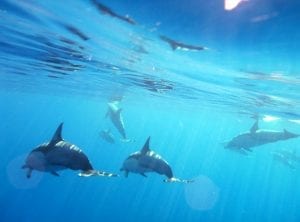DOLPHIN COMMUNICATION
Dolphins have a complex and intricate visual, acoustic and chemical communication system. They are particularly reliant on their acoustic communication faculty to effectively and efficiently hunt, navigate, maintain contact between group members and advertise individual identity and activity.
Most species of dolphins produce a large variety of acoustic signals that are generally categorised as whistles, clicks and broad band signals. Little is know about the specific functions and ecological significance of these complex sounds produced by dolphins.
This study will examine the types of acoustic emissions produced by coastal dolphins and investigate the functions of these sounds. Innovative and technologically advanced equipment will be developed to obtain recordings of concurrent underwater and directional sound recordings. This study involves an international team of leading researchers. We believe that the development and use of this equipment will drastically improve the techniques used to record dolphin behaviour and acoustics which have previously been very limiting.
Findings from this study will advance the understanding of ecological requirements of these highly social marine mammals that rely on their acoustic communication to survive.
Listen to Dolphins
Bottlenose dolphin chasing fish chasing fish1
Bottlenose dolphin whistling contact callsa
Australian Humpback Dolphin & Indo-Pacific Bottlenose Dolphin Acoustic Communication
Little is known about the acoustic communication systems of the Australian humpback dolphin. This project will provide insight into the acoustic communication systems of these vulnerable animals. It’ll examine the vocal repertoire of humpback dolphins in Moreton Bay, how variable acoustic emissions are during different behavioural contexts, variations between social groups and how different soundscapes may influence their communication. These results will be compared with the Indo-Pacific bottlenose dolphins which live sympatrically with humpback dolphins. This project is currently in the early stages with opportunistic sound recordings being made during our Moreton Bay Dolphin Research Expeditions with our Eco-Volunteer teams.


